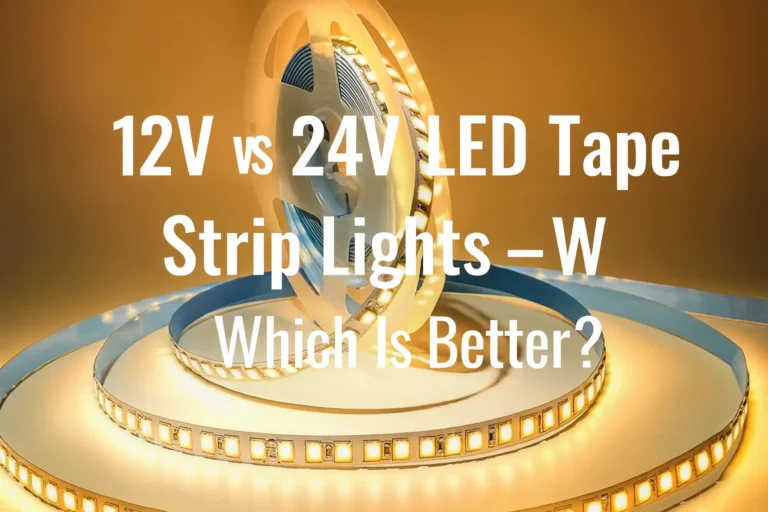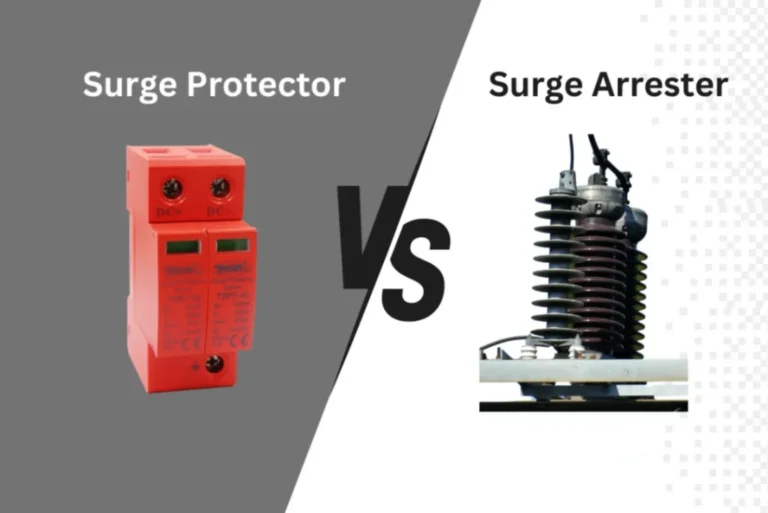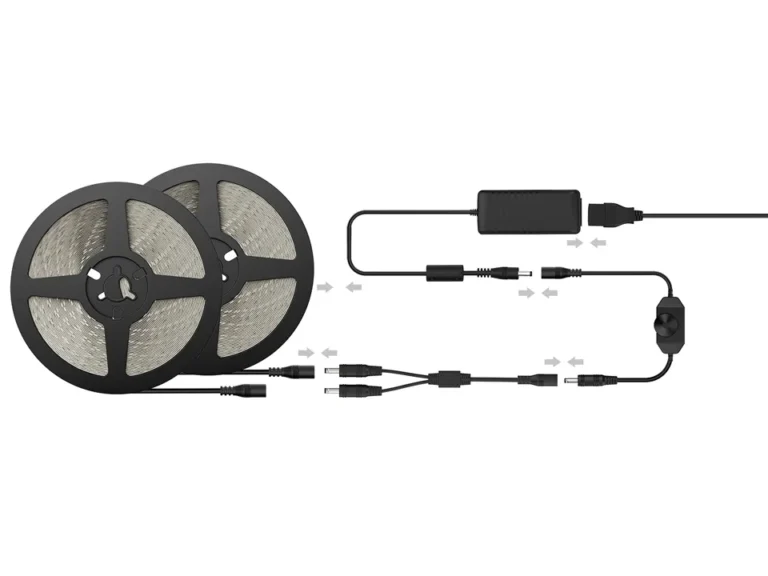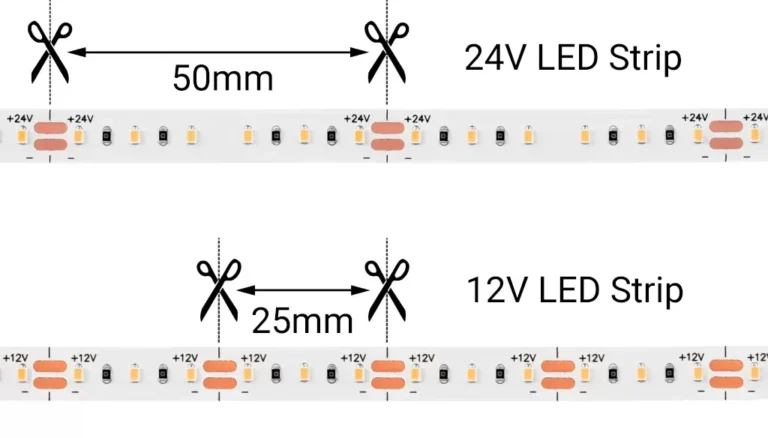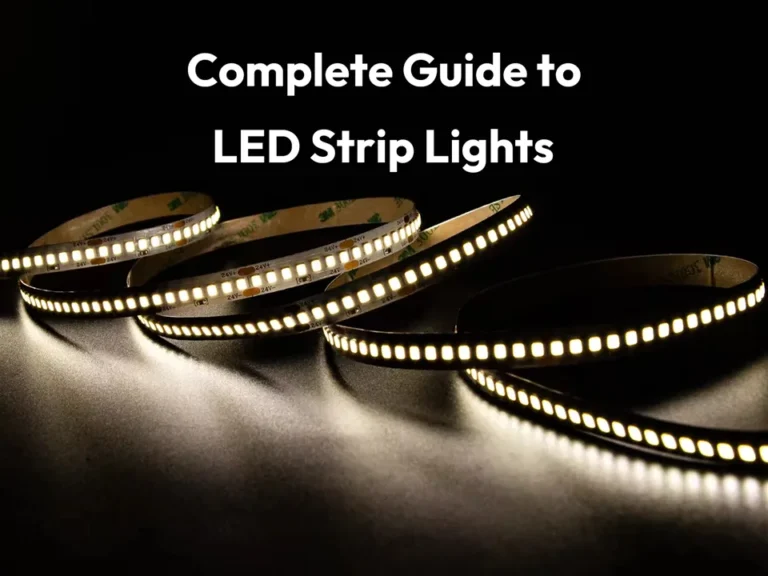introdução
Em iluminação de tiras de led Instalações, seleção de tensão geralmente é subestimada, mas impacta diretamente na consistência do brilho, na eficiência energética e nos custos de manutenção a longo prazo. Muitos instaladores passaram por situações frustrantes - tiras de LED escurecendo na metade de uma corrida ou alimentações frequentes necessárias após a instalação. Na maioria dos casos, esses problemas são causados pela escolha do sistema de tensão incorreto: 12V, 24V ou 48V. Para uma comparação mais profunda entre as duas tensões mais comuns, consulte nosso guia completo: Luzes de tiras de LED de 12 V vs 24 V - como escolher.
Escolher a voltagem correta da faixa de LED é crucial para evitar queda de tensão – uma perda de tensão que acontece quando a corrente elétrica percorre a tira, causando brilho irregular e energia desperdiçada. Os sistemas de alta tensão reduzem a corrente para a mesma potência, o que minimiza a queda de tensão e o acúmulo de calor, especialmente em corridas longas.
Por exemplo, as tiras de LED de 12 V oferecem alta flexibilidade e são ideais para projetos de bricolage de curto prazo; as tiras de LED de 24 V atingem um ótimo equilíbrio entre desempenho e custo para corridas de médio comprimento; enquanto as tiras LED de 48 V se destacam em instalações de longa distância e projetos de engenharia de grande escala. Este guia irá quebrar o básico de tensão, diferenças de desempenho e cenários de melhor uso, ajudando você a escolher a tensão certa para qualquer projeto de iluminação com confiança.

Entendendo a tensão da faixa de LED
Ao selecionar a tensão da faixa de LED, é importante entender a relação entre a tensão e o comprimento máximo de operação para as luzes de tiras de LED.
Para tiras de LED de tensão constante, uma tensão mais alta significa que é necessária menos corrente para fornecer a mesma potência, o que ajuda a reduzir a queda de tensão e manter um brilho consistente em todo o comprimento da tira.
Especificações típicas:
tiras de LED de 12 V: Manter um brilho estável até cerca de 5 metros (16 pés); além desse comprimento, pode ocorrer um escurecimento perceptível.
tiras de led de 24 v: Comumente, suporte para corridas de cerca de 10 metros (33 pés), com algumas opções de alta qualidade atingindo até 15 metros.
tiras de LED de 48 V: pode correr de 15 a 20 metros (50 a 65 pés) ou mais; quando emparelhado com um sistema de tiras LED de corrente constante, comprimentos de 30 a 40 metros (100 a 130 pés) ou mais são alcançáveis.
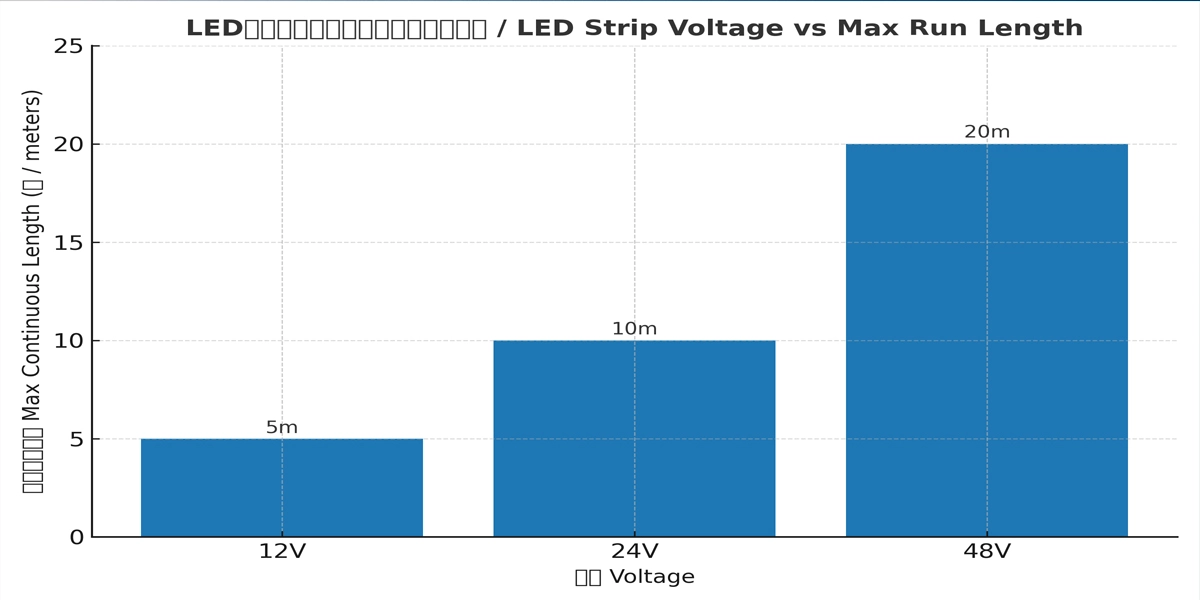
Outro conceito-chave é a tensão constante versus a corrente constante:
As faixas de LED de tensão constante (como 12 V, 24 V, 48 V) usam uma fonte de alimentação de tensão fixa e são simples de instalar e controlar, mas são mais propensas a quedas de tensão em longas distâncias.
As tiras de LED de corrente constante fornecem uma saída de corrente estável, garantindo um brilho uniforme e uma temperatura de cor em comprimentos estendidos - ideais para projetos de grande escala que exigem o máximo desempenho e consistência.
Ao entender esses fundamentos, você pode escolher a voltagem correta da faixa de LED que equilibra o comprimento da instalação, a consistência do brilho, a complexidade da fiação e o custo geral, garantindo eficiência e qualidade visual.
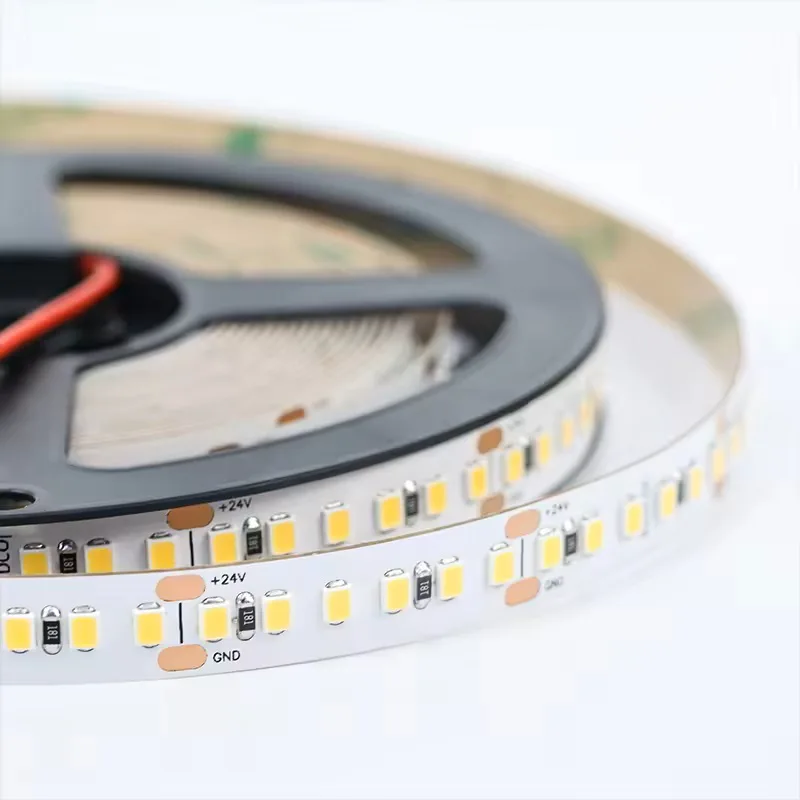
Fita LED SMD2835
Modelo principal: FQX08T120C
LED QTY por metro Opção: 60/72/120/128/140
Opção de largura do PCB: 6mm/8mm/10mm
Opção de cor: 2700K/3000K/4000K/5000K/6500K
Opção CRI: 80/90
Tensão de entrada: DC12V/DC24V
Potência por metro: 6W/8W/9.6W/12W/14.4W/19.2W
Eficiência: 100-200 lúmenes/watt
Opção de grau IP: IP20/IP54/IP65/IP67/IP68
Garantia: 5 anos
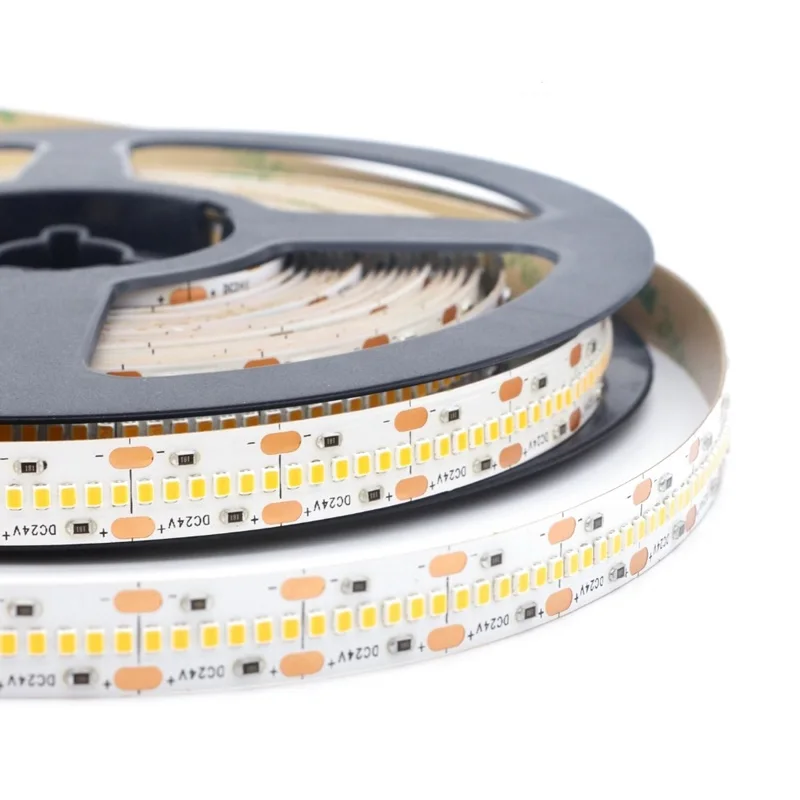
Fita LED SMD2216
Modelo principal: FWX10T240C
LED QTY por metro Opção: 120/180/240/300/420
Opção de largura do PCB: 5mm/10mm
Opção de cor: 2700K/3000K/4000K/5000K/6500K
Opção CRI: 80/90
Tensão de entrada: DC12V/DC24V
Potência por metro: 9.6W/10W/14.4W/19.2W/20W/24W
Opção de grau IP: IP20/IP54/IP65/IP67/IP68
Garantia: 5 anos

Fita LED de corrente constante de longa duração
Modelo principal: FQX10T120D
Opção de metro por rolo: 10m/20m/30m/50m
Opção de largura do PCB: 10mm/12mm
Opção de cor: 2700K/3000K/4000K/5000K/6500K
Opção CRI: 80/90
Tensão de entrada: DC24V/DC36V/DC48V
Potência por metro: 4,2W/7,2W/8,5W/12W
Opção de grau IP: IP20/IP54/IP65/IP67/IP68
Garantia: 5 anos
Quando escolher luzes LED de 12, 24 V ou 48 V
Luzes de tiras de LED de 12V
As luzes de tiras de LED de 12 V operam em uma tensão mais baixa, o que significa maior corrente para a mesma potência. Esse design permite intervalos de corte mais curtos - normalmente 25 a 50 mm - tornando-os perfeitos para instalações detalhadas, como prateleiras de exibição, detalhes em móveis e interiores automotivos.
No entanto, como os sistemas de baixa tensão são mais propensos a queda de tensão, funciona mais do que 5 m sem que a injeção de energia possa levar a uma perda perceptível de brilho. Isso se deve à resistência nos condutores e fiação da tira, uma limitação mais pronunciada em 12 V do que em sistemas de 24 V ou 48 V.

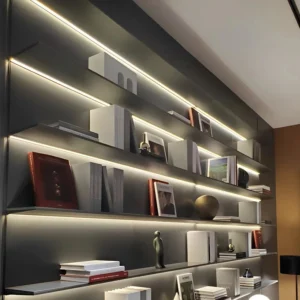
Melhor para:
Curtas curtas até 5 m sem perda de brilho visível
Iluminação decorativa e de destaque em móveis, prateleiras e pequenos espaços
Sistemas de baixa tensão automotivos, marinhos, RV e solares
Prós:
- Baixo custo inicial e drivers e dimmers amplamente disponíveis
- Instalação flexível devido a intervalos curtos de corte
- Forte compatibilidade com sistemas baseados em bateria de 12 V
Contras:
- Queda de tensão perceptível em funcionamentos mais longos sem injeção de energia
- Menor eficiência em comparação com sistemas de alta tensão para longas distâncias
Luzes de tiras de LED de 24 V
Luzes de tiras de LED de 24 V dobram a tensão dos sistemas de 12 V, cortando a corrente pela metade para a mesma potência. Isso reduz o acúmulo de calor e a queda de tensão, permitindo que funcionem até 10 m sem perda de brilho.
A tensão mais alta significa melhor eficiência e iluminação mais estável para aplicações como iluminação de Cove de Hotel, prateleiras de varejo e iluminação de destaque para escritórios. Embora os intervalos de corte sejam normalmente mais longos (50–100 mm), limitando o corte ultrapreciso, o equilíbrio geral entre eficiência, custo e estabilidade do brilho faz 24 V a escolha preferida para muitos projetos comerciais.

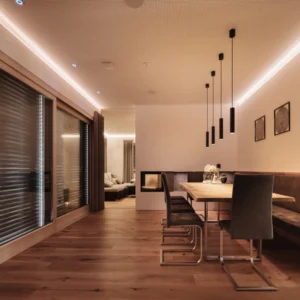
Melhor para:
Instalações de médio porte em torno de 10 m
Iluminação comercial em hotéis, escritórios e expositores de prateleiras
Espaços que exigem brilho consistente e desempenho suave de escurecimento
Prós:
- Baixa corrente reduz o calor e melhora a eficiência em corridas médias
- Relação de custo-desempenho equilibrada para a maioria das aplicações comerciais
- Ampla compatibilidade com drivers de nível profissional e controladores DMX/DALI
Contras:
- Intervalos de corte maiores reduzem a flexibilidade em instalações de ajuste apertado
- Custo inicial ligeiramente superior ao dos sistemas de 12 V
Luzes de tiras de LED de 48V
As luzes LED de 48V oferecem o fluxo de corrente mais baixo para a mesma potência, minimizando drasticamente a queda de tensão mesmo em distâncias de 15 a 20 m ou mais. Isso permite um brilho uniforme em instalações de grande porte, como fachadas de construção, enseadas longas ou recursos arquitetônicos externos sem pontos de injeção de energia frequentes.
A complexidade da fiação reduzida e menos fontes de alimentação reduzem os custos de instalação e manutenção. No entanto, os intervalos de corte são os mais longos (100–200 mm), limitando o uso em projetos que exigem ajustes de precisão. Além disso, drivers e sistemas de escurecimento compatíveis são menos comuns em comparação com as opções de 12 e 24 V.
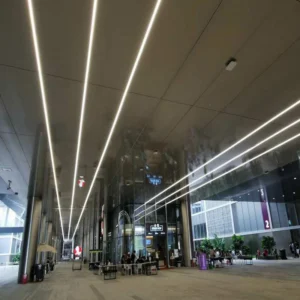
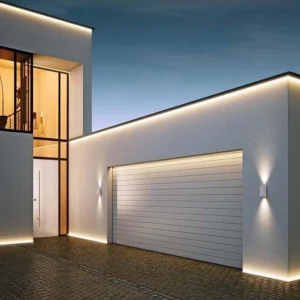
Melhor para:
Instalações de longa distância de 15 a 20 m ou mais
Iluminação de fachadas arquitetônicas, enseadas de teto e grandes projetos ao ar livre
Projetos comerciais ou de engenharia com o objetivo de minimizar a fiação e alimentação de energia
Prós:
- Corrente mais baixa entre as três tensões, oferecendo o brilho mais estável
- Alta eficiência energética em longas distâncias
- Menos fontes de alimentação necessárias, reduzindo a complexidade e a manutenção da fiação
Contras:
- Disponibilidade limitada de drivers e controladores compatíveis em comparação com 12V/24V
- Intervalos longos de corte reduzem as opções de personalização em espaços apertados
Guia de seleção de tensão de tira de LED
| Tensão | melhor para | Comprimento máximo do percurso | Intervalo de corte típico | Faixa de potência comum (W/m) | Prós | Contras |
| 12V | Corridas curtas ≤ 5 m; iluminação decorativa; automotivo, marítimo, RV, sistemas solares | ~5 m | 25–50 mm | 4,8–14,4 W/m | Baixo custo; intervalos curtos de corte; alta compatibilidade com sistemas de bateria de 12V | Queda de tensão mais alta em corridas longas; menor eficiência para distâncias prolongadas |
| 24V | Média funciona ~10 m; hotéis, escritórios, prateleiras de varejo; escurecimento consistente | ~10 m | 50–100 mm | 7,2–19,2 W/m | Baixa corrente reduz o calor; bom equilíbrio custo-desempenho; compatível com os motoristas profissionais | Intervalos de corte mais longos que 12 V; custo ligeiramente mais alto |
| 48V | Longas corridas de 15 a 20 m+; fachadas arquitetônicas, grandes projetos ao ar livre | 15–20+ m | 100–200 mm | 10–20 W/m | Baixa corrente, queda de tensão mínima; maior eficiência em corridas longas; menos fontes de alimentação são necessárias | Opções limitadas de driver/controlador; intervalos de corte mais longos |
* O comprimento máximo da execução é baseado na instalação padrão sem injeção de energia adicional.
Erros a evitar ao escolher a tensão da faixa de LED
Escolher a tensão errada da tira de LED pode levar à perda de brilho, superaquecimento ou retrabalho caro. Aqui estão os erros mais comuns a serem evitados:
Usando tiras de 12 V para corridas longas sem injeção de energia
As tiras de LED de 12V são ideais para corridas curtas (≤5 m). Usá-los para distâncias maiores sem adicionar alimentação extra de energia causará uma queda de brilho visível.
Cortar a tira na posição errada
Seja 12V, 24V ou 48V, sempre corte nas almofadas de cobre designadas. Corte em outro lugar pode danificar o circuito e tornar a tira inutilizável.
Combinando a tensão errada da fonte de alimentação
Nunca conecte uma tira de 12 V a uma fonte de alimentação de 24 V ou 48 V (ou vice-versa). Isso pode queimar instantaneamente os LEDs.
Saiba mais sobre por que as tensões incompatíveis podem danificar seus LEDs em nosso guia detalhado: Conectando as tiras de LED de 12 V em uma fonte de alimentação de 24 V.
Ignorando os cálculos de queda de tensão
Para corridas acima de 5 m (12 V), 10 m (24 V) ou 20 m (48 V), calcule a queda de tensão com antecedência e planeje a injeção de energia ou sistemas de alta tensão.
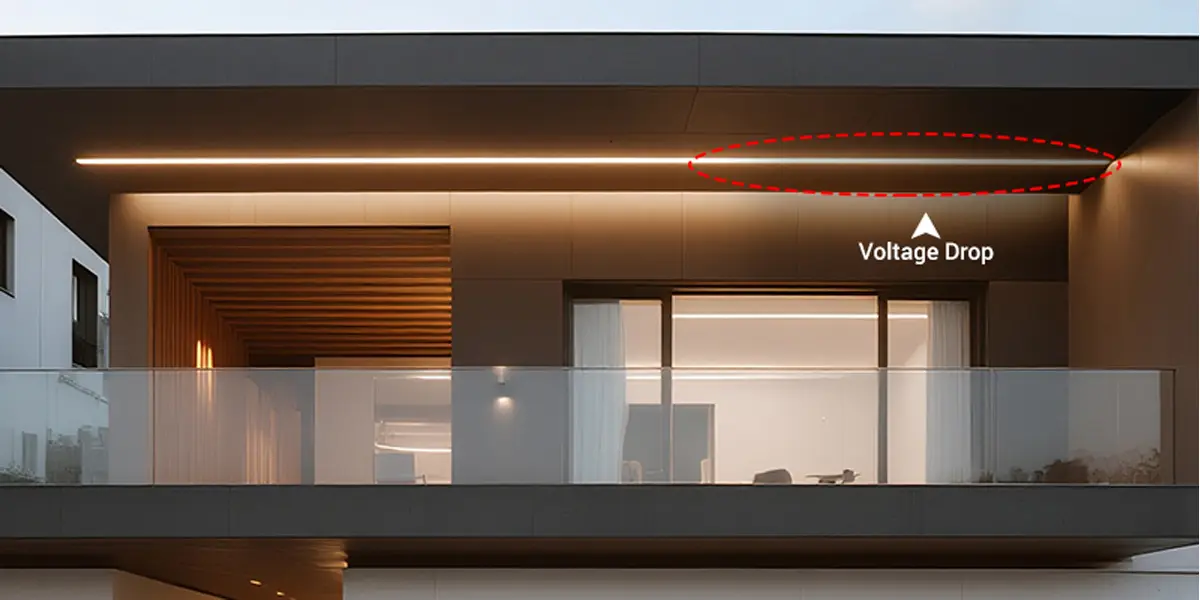
sobrecarregando a fonte de alimentação
Sempre escolha um driver com pelo menos 20–30% mais capacidade do que a potência total de suas tiras de LED.
FAQ – Seleção de tensão de tira de LED
não . Fornecer tensão mais alta que a tira é classificada para overdrive os LEDs, causando superaquecimento, danos ou falha instantânea. Sempre combine a tensão da tira com a tensão da fonte de alimentação.
Para a maioria das instalações externas, as faixas de LED de 24 V ou 48 V são preferidas porque permitem corridas mais longas com menos queda de tensão, o que é importante para iluminação arquitetônica ou fachada em grande escala.
12V: até 5 m sem injeção de energia
24V: até 10 m sem injeção de energia
48V: até 15–20 m sem injeção de energia
As corridas mais longas exigem alimentação adicional ou fiação paralela.
As tiras de LED de 12 V são as melhores para aplicações automotivas, marítimas e RV porque são diretamente compatíveis com sistemas de bateria de 12 V. Se você planeja conectar várias tiras de LED de 12 V a uma fonte de alimentação, leia nosso guia passo a passo: Você pode conectar várias tiras de LED de 12 V a uma fonte de alimentação?
Não necessariamente. O brilho depende do tipo de LED, densidade (LEDs por metro) e potência. A tensão afeta principalmente o comprimento e a eficiência da corrida.
Conclusão
A escolha da tensão correta da faixa de LED afeta não apenas os resultados da instalação, mas também a consistência do brilho, a eficiência energética e os custos de manutenção.
Corridas curtas e iluminação de precisão: opte por 12 V para cortes e compatibilidade compatíveis com sistemas de bateria de baixa tensão.
Corridas médias e espaços comerciais: escolha 24 V para uma combinação equilibrada de desempenho e custo.
Longas corridas e projetos de grande escala: opte por 48V para minimizar a queda de tensão e simplificar a fiação.
Para obter o melhor resultado, considere o comprimento da corrida, os requisitos de corte, o layout da potência e a segurança antes de decidir - isso garante o equilíbrio ideal entre desempenho, custo e manutenção.
Para estimar o uso e eficiência de energia do seu projeto, consulte nosso guia completo: Quanta eletricidade uma luz LED tira usa?

